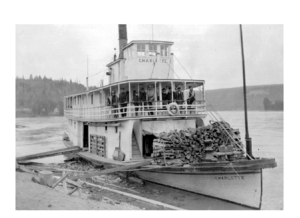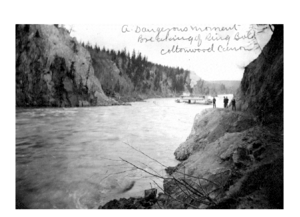Charlotte (sternwheeler) facts for kids

Charlotte at Quesnel 1898
|
|
Quick facts for kids History |
|
|---|---|
| Name | Charlotte |
| Builder | Alexander Watson |
| Laid down | 1896 |
| Launched | August 3, 1896 Quesnel |
| In service | 1896-1910 |
| Fate | Wrecked at Fort George Canyon, salvaged and abandoned at Quesnel in 1910 |
| Notes | Captain Frank Odin (first captain); Captain Owen Forrester Browne |
| General characteristics | |
| Length | 126 ft (38.4 m) |
| Beam | 23 ft (7.0 m) |
| Notes | No. 103909 |
The Charlotte was a special type of boat called a sternwheeler. It was built in 1896 by Alexander Watson. This boat was made for a company called the Northern British Columbia Navigation Company. The main people in this company were Stephen Tingley, Senator James Reid, and John Irving. The Charlotte was launched on August 3, 1896. James Reid's wife christened the boat, meaning she officially named it after herself.
Contents
Traveling the Fraser River
The Charlotte was built to travel a specific route on the upper Fraser River. This route went from Soda Creek to Quesnel. The Charlotte was much better than older boats like the Enterprise and the Victoria. Those boats had used the same route from the 1860s to the 1880s.
First Journey and Winter Break
The first captain of the Charlotte was Frank Odin. Her first season was very short because she was launched late in the year. It was also almost a disaster! In mid-November, Captain Odin was bringing the boat back from Quesnel to Soda Creek. He saw that ice was starting to form and float down the river.
Captain Odin had to tie the Charlotte up at Steamboat Landing. This spot was near Alexandria, right where the old, broken boat Victoria was. The owners didn't want the Charlotte to get stuck in the frozen river all winter. So, they decided to buy the old Victoria wreck. This way, the Charlotte could be safely parked in its place for the winter.
Years of Service and New Plans
For the next twelve years, the Charlotte worked hard. She regularly traveled between Soda Creek and Quesnel. She delivered mail and other goods to the small towns and communities along the river. Her owners didn't want to risk taking her further north. There were dangerous parts of the river like the Cottonwood and Fort George canyons.
Around 1907, people learned that a big railway, the Grand Trunk Pacific Railway, was coming. It would pass through Fort George. This made the Charlotte's owners think about extending the boat's route further north. An older boat, the Enterprise, had gone through these canyons before. But the owners knew it would still be very risky for the Charlotte to do it regularly.
Preparing for New Routes
The town of Quesnel was also planning to build its own river boat. It was set to launch in 1909. A local man, Captain DA Foster, was going to be its pilot. In the fall of 1907, he checked out the canyons. He then asked the government for money to clear away obstacles in the river. He received $13,000 for this work and personally oversaw the clean-up of the two canyons.
Because of these improvements and the news about the railway, the Charlotte's owners decided to upgrade her. They made her engine more powerful. They also replaced her old hand-cranked capstan (a machine used to pull ropes) with a strong steam-powered one. During this time, they hired Captain Owen Forrester Browne to be her new pilot.
Throughout 1908, Captain Browne took the Charlotte to the start of the Cottonwood Canyon many times. He learned a lot about the area. After talking a lot with local First Nation's people, Captain Browne decided to try going through the canyon.
Journey to Fort George
In the fall of 1908, Captain Browne made the Charlotte's first test trip through the canyons. One of the owners, Captain Irving, joined him. The Charlotte had her powerful new capstan and plenty of wood for fuel. They reached the start of the Cottonwood Canyon. The crew attached a rope to a new metal ring that was placed there. Captain Browne began to pull the boat through the canyon.
A Close Call
The Charlotte was almost at the end of the canyon when the metal ring broke! The boat crashed backward through the canyon. Captain Browne reacted very quickly. He steered the Charlotte past a pile of rocks. If she had hit them, the boat would have been badly damaged and sunk right away.
After this scary incident, Browne and Irving went back to Quesnel. They asked the government for more money. This time, they wanted to blast away a large rock in the Cottonwood Canyon. This rock was making the river current too strong. Captain Browne was sure that once this rock was gone, the canyon would be safe to travel. The money was given, and the canyon was ready for the 1909 travel season.
New Boats and Final Journey
By the spring of 1909, two other river boats joined the Charlotte. These were the Quesnel, which Captain Foster had planned, and the Nechacco. The Nechacco was owned by the Fort George Lumber and Navigation Company. All three boats were able to travel the full route from Soda Creek to South Fort George.
By 1910, three more boats had joined the group: the BX, Chilcotin, and Fort Fraser. The Charlotte had a few small accidents that summer. Then, on July 15, she had a major one. She hit a hidden rock in the Fort George Canyon and sank.
The damage was so bad that it took until October to pull her out of the water and bring her to Quesnel. Her owners looked at how much it would cost to fix her. They also knew that the Charlotte was an older, smaller boat and couldn't compete with the newer, bigger BX. So, they decided it wasn't worth spending more money on her. The Charlotte was left on the riverbank at Quesnel and never used again.
See also


